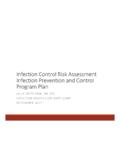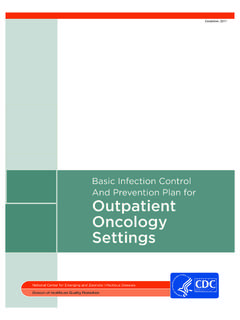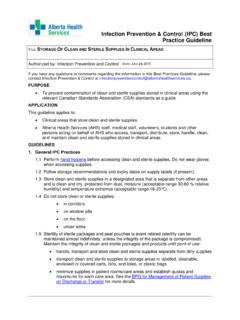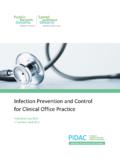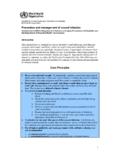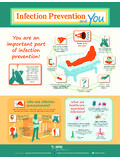Transcription of GUIDE TO INFECTION PREVENTION FOR OUTPATIENT SETTINGS
1 GUIDE TO INFECTION PREVENTION FOR OUTPATIENT SETTINGS : MINIMUM EXPECTATIONS FOR SAFE CAREN ational Center for Emerging and Zoonotic Infectious DiseasesDivision of Healthcare Quality PromotionVersion - September 20162 Version September 2016 NOTE TO READERSThe following document is a summary GUIDE of INFECTION PREVENTION recommendations for OUTPATIENT (ambulatory care) SETTINGS . The recommendations included in this document are not new but rather reflect existing evidence-based guidelines produced by the Centers for Disease Control and PREVENTION and the Healthcare INFECTION Control Practices Advisory Committee. This summary GUIDE is based primarily upon elements of Standard Precautions and represents the minimum INFECTION PREVENTION expectations for safe care in OUTPATIENT SETTINGS . Readers are urged to use the INFECTION PREVENTION Checklist for OUTPATIENT SETTINGS (Appendix A), a companion to the summary GUIDE , and to consult the full guidelines for additional background, rationale, and evidence behind each recommendation.
2 All guidelines are available at: September 2016 INTRODUCTIONThe transition of healthcare delivery from acute care hospitals to OUTPATIENT (ambulatory care) SETTINGS , along with ongoing outbreaks and patient notification events ( ), have demonstrated the need for greater understanding and implementation of basic INFECTION PREVENTION guidance. This GUIDE to INFECTION PREVENTION for OUTPATIENT SETTINGS : Minimum Expectations for Safe Care distills existing INFECTION PREVENTION guidance from the Centers for Disease Control and PREVENTION (CDC) and the Healthcare INFECTION Control Practices Advisory Committee (HICPAC). Over the past several decades, we have witnessed a significant shift in healthcare delivery from the acute, inpatient hospital setting to a variety of OUTPATIENT and community-based SETTINGS . OUTPATIENT care is provided in hospital-based OUTPATIENT clinics, nonhospital-based clinics and physician offices, ambulatory surgical centers, and many other specialized SETTINGS .
3 Americans have frequent encounters with OUTPATIENT SETTINGS . For example, more than three-quarters of all operations in the United States are performed in SETTINGS outside the In addition, between 1995 and 2007, the average person made three visits each year to physician By 2007, the total number of physician offices visits approached one Vulnerable patient populations rely on frequent and intensive use of OUTPATIENT care to maintain or improve their health. For example, each year more than one million cancer patients receive OUTPATIENT chemotherapy, radiation therapy, or both4. It is critical that all of this care be provided under conditions that minimize or eliminate risks of healthcare-associated infections (HAI).Compared to inpatient acute care SETTINGS , OUTPATIENT SETTINGS have traditionally lacked infrastructure and resources to support INFECTION PREVENTION and surveillance activities5,6,7. While data describing risks for HAI are lacking for most OUTPATIENT SETTINGS , numerous outbreak reports have described transmission of gram-negative and gram-positive bacteria, mycobacteria, viruses, and parasites8,9.
4 In many instances, outbreaks and other adverse events were associated with breakdowns in basic INFECTION PREVENTION procedures ( , reuse of syringes leading to transmission of bloodborne viruses). All healthcare SETTINGS , regardless of the level of care provided, must make INFECTION PREVENTION a priority and must be equipped to observe Standard Precautions. The 2007 CDC and HICPAC Guideline for Isolation Precautions was a first attempt to provide recommendations that can be applied in all healthcare SETTINGS . The GUIDE presented here is based primarily upon elements of Standard Precautions from that guideline and represents the minimum INFECTION PREVENTION expectations for safe care in OUTPATIENT SETTINGS . It is intended for use by anyone needing information about general INFECTION PREVENTION measures in OUTPATIENT SETTINGS . To assist with conducting periodic assessments of INFECTION PREVENTION policies and practices, the reader is referred to the INFECTION PREVENTION Checklist for OUTPATIENT SETTINGS , which appears at the end of this document as Appendix the purposes of this document, OUTPATIENT care is defined as care provided in facilities where patients do not remain overnight ( , hospital-based OUTPATIENT clinics, non-hospital based clinics and physician offices, urgent care centers, ambulatory surgical centers, public health clinics, 4 Version - September 2016imaging centers, oncology clinics, behavioral health clinics and physical therapy and rehabilitation centers).
5 Healthcare personnel (HCP) are defined as all persons, paid and unpaid, working in OUTPATIENT SETTINGS who have the potential for exposure to patients and/or to infectious materials, including body substances, contaminated medical supplies and devices, contaminated environmental surfaces, or contaminated air. This includes persons not directly involved in patient care ( , clerical, house-keeping, and volunteers) but potentially exposed to infectious agents that can be transmitted to and from HCP and patients. This document does not replace existing, more-detailed guidance for hemodialysis centers or dental practices (available at: and , respectively). Further, the reader is referred to other CDC and HICPAC guidelines and websites for more detailed information and for recommendations concerning specialized INFECTION PREVENTION issues ( , sterilization and disinfection of reusable devices, multi-drug resistant organisms).5 Version - September 2016 OBJECTIVESBy highlighting existing CDC and HICPAC recommendations, this summary GUIDE : 1) provides basic INFECTION PREVENTION recommendations for OUTPATIENT (ambulatory care) SETTINGS ; 2) reaffirms Standard Precautions as the foundation for preventing transmission of infectious agents during patient care in all healthcare SETTINGS ; 3) provides links to full guidelines and source documents, which readers can reference for more detailed background and - September 20166 FUNDAMENTAL ELEMENTS NEEDED TO PREVENT TRANSMISSION OF INFECTIOUS AGENTS IN OUTPATIENT SETTINGSD edicate Resources to INFECTION PREVENTION (Administrative Resources) INFECTION PREVENTION must be made a priority in any setting where healthcare is delivered.
6 Those with primary administrative oversight of the OUTPATIENT facility must ensure that sufficient fiscal and human resources are available to develop and maintain INFECTION PREVENTION and occupational health programs. This includes the availability of sufficient and appropriate equipment and supplies necessary for the consistent observation of Standard Precautions, including hand hygiene products, injection equipment, and personal protective equipment ( , gloves, gowns, face and eye protection). INFECTION PREVENTION programs must extend beyond Occupational Safety and Health Administration (OSHA) bloodborne pathogens training to address patient protection. Facilities should assure that at least one individual with training in INFECTION PREVENTION is employed by or regularly available ( , by contract) to manage the facility s INFECTION PREVENTION program. This individual should be involved in the development of written INFECTION PREVENTION policies and have regular communication with HCP to address specific issues or concerns related to INFECTION PREVENTION .
7 The development and ongoing refinement of INFECTION PREVENTION policies and procedures should be based on evidence-based guidelines, regulations, or standards. These policies and procedures should be tailored to the facility and re-assessed on a regular basis ( , annually), taking into consideration the types of services provided by the facility and the patient population that is served. This process (referred to as risk assessment by the INFECTION PREVENTION profession) will allow facilities to better prioritize resources and focus extra attention on those areas that are determined to pose greater risk to their patients. For example, an ambulatory surgical center, which performs on-site sterilization of reusable surgical devices, would be expected to have more detailed policies regarding device reprocessing than a primary care office, where on-site sterilization is less likely to be performed. However, both facilities should have policies and procedures addressing handling of reusable medical devices.
8 Similarly, a clinic primarily serving patients infected with tuberculosis will have INFECTION PREVENTION needs beyond those of a general pediatric office. Facility administrators should also assure that facility policies and procedures address occupational health needs including vaccination of HCP, management of exposures or infections in personnel requiring post-exposure prophylaxis and/or work restrictions, and compliance with the OSHA bloodborne pathogens standard. Recommendations for PREVENTION of infections in HCP can be found in the following resources: Guideline for INFECTION control in healthcare personnel (available at: ), Recommended Vaccines for Healthcare Workers (available at: ), and OSHA Bloodborne Pathogens and Needlestick PREVENTION (available at: ).7 Version - September 2016 Key administrative recommendations for OUTPATIENT SETTINGS :1. Develop and maintain INFECTION PREVENTION and occupational health Assure availability of sufficient and appropriate supplies necessary for adherence to Standard Precautions ( , hand hygiene products, personal protective equipment, injection equipment).
9 3. Assure at least one individual with training in INFECTION PREVENTION is employed by or regularly available ( , by contract) to manage the facility s INFECTION PREVENTION Develop written INFECTION PREVENTION policies and procedures appropriate for the services provided by the facility and based upon evidence-based guidelines, regulations, or and Train Healthcare PersonnelOngoing education and competency-based training of HCP are critical for ensuring that INFECTION PREVENTION policies and procedures are understood and followed. Education on the basic principles and practices for preventing the spread of infections should be provided to all HCP. Training should include both HCP safety ( , OSHA bloodborne pathogens training) and patient safety, emphasizing job- or task-specific needs. Training should be provided upon orientation to the facility and, to maintain competency, should be repeated annually and anytime policies or procedures are updated/revised.
10 Competencies should be documented following each training. Key recommendations for education and training of healthcare personnel in OUTPATIENT SETTINGS :1. Provide job- or task-specific INFECTION PREVENTION education and training to all This includes those employed by outside agencies and available by contract or on a volunteer basis to the Training should focus on principles of both HCP safety and patient Training should be provided upon hire and repeated annually and when policies or procedures are Competencies should be documented following each and Report Healthcare-associated infections Surveillance is defined as the ongoing, systematic collection, analysis, interpretation, and dissemination of data regarding a health-related event for use in public health action to reduce morbidity and mortality and to improve health. Surveillance typically refers to tracking of outcome measures ( , HAIs) but can also refer to tracking of adherence to specific process measures ( , hand hygiene, environmental cleaning) as a means to reduce INFECTION transmission.










